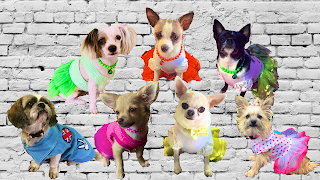Its The Great Debate to Shoe or not to Shoe Your Furbaby?
Don’t suppose your dog needs dog boots, shoes, or booties
Re-evaluate. While the general public believe that dog shoes are only for fun and fashion, there are several legitimate reasons why your dog would profit by sporting them.
The Great Outdoors.
Do you have a full of life outside dog that you take hiking, running, hunting, or biking with you? A perfect approach to safeguard your dog’s paws from outside dangers is to use durable dog boots created especially for rough outsideconditions. There are a number of dangerous things that may happen to a dog’s sensitive pads and also the areas between them. It's attainable that the pads will sustain cuts or perhaps wear out if you're taking your dog hiking on slippery, rocky mountain trails or sprinting on hard pavement. Dog boots will offer further protection against all of thosehazards.
Health Problems.
Orthopedic dog boots might help an older dog whose paws and back are beginning to show indications of wear and tear or assist a breed of dog that’s susceptible to hip problems. Vets typically advise orthopedic dog shoes for the additional padding and support they supply. These dog boots shield the toes from being rubbed raw, particularly if you've got an older dog that drags his feet while he walks. Making your dog a lot more stable can increase his mobility. Contemplate trying orthopaedic dog boots for a happier, healthier dog.
Summertime Blues.
To protect your dog’s feet from blazing hot asphalt and cement throughout the summer months, use dog booties. remembering what it feels like when you go without shoes on the hot sand or pool deck will make you appreciate howthe warmth would possibly hurt your dog’s paws. Light-weight sandals will make his summer walks far more comfy, and pool and water shoes help shield pool liners from tears in conjunction with providing non-slip protection on wet surfaces.
Winter Chill.
Waterproof rain boots are lifesavers for your scratchable hard floors and floor coverings that aren’t easily cleaned. Most dogs don’t mind getting wet and don’t care if their paws are dirty. They are going to return bounding into the house after being outside without a moment’s hesitation, spreading water and dirt around and usually wreaking mayhem. Waterproof boots are often removed before your dog comes into the house, saving you from clean-up duty on a wet and rainy morning or afternoon.
Think about the conditions that your dog is habitually exposed to: weather, rough concrete , health problems, old age. Would he use some protective footwear? place yourself in your dog’s shoes and think about trying a pair of shoes that might make him happier and more well-off today.
Best Sort Of Dog Shoes
The best style of dog shoes can enable a dog’s paws to perform as ordinarily as possible while not putting pressure on a dog’s natural walking or running motion or paw movement, and therefore the right style of dog shoes won't rub against the dog’s paws or cause blisters or sores throughout their use.
For most purposes, dog shoes that are made out of a flexible, soft and sturdy material will facilitate to safeguard a dog’s paws while not inflicting friction sores and can enable a dog to run as naturally as possible. Shoes for dogs that have straightforward to shut adjustable tops will be simple to place on and off and can not become too tight round the dog’s legs.
Using Dog Shoes.
Dogs don't typically like having their paws wrapped in shoes, and they need to be introduced to shoe wear step by step. Pet mums and dads should place the shoes on for just a couple of minutes each day, and reward the dog with a treat and praise just when the shoes are placed on the paws. Once a dog becomes accustomed to the feeling of the shoes, pet owners can attempt walking their dogs for increasing periods of time while the dog shoes are on.
This is Chickeeta one of Miss Mildred's friends on Facebook.
I have been looking into why Chicky's little paws keep peeling off and becoming sore and red poor little love bug! Miss Mildred and I have been researching lots of reasons for why this is going on, And we have found that the most likely problem is the lack of zinc in her diet or a fungus that is causing her to be in pain!
We will go in to more details in a upcoming blog, Yet we are happy to tell you that Chickeeta's mum Lisa is putting shoes on her little feet to protect her fragile paws from the possible dangers that might irritate her paws! I Miss Squeak have pasted some helpful foot soak recipes to Chickeeta's mum Lisa and I will share the results with all of you once I hear of the outcome, Hopefully we have good news to report but to everyone who reads my blog.
Miss Mildred wears shoes all the time.
As she never liked walking on cold wet grass to go to toilet
So I started to train her to wear shoes, I have had many nasty comments mainly on Facebook regarding her wearing shoes, or dresses and winter coats, silly small minded people!
When this first happened I was so hurt by this as I was called a animal abuser, was told to stop dressing my chihuahua like a doll and to grow up hmmm!
I continue to dress my little girl Miss Mildred as she is a fragile Chihuahua that feel the cold so I protect her from the elements!
If that is what makes me a bad furbaby mum then gee whizz lock me up and throw away the key! She even has house socks haha!
Here are some more things about your furbabies paws!
The dog’s pad is the toughest part of a dog’s body. This thick spongy structure, located under the dog’s foot, absorbs a lot of pressure from running, standing and walking. Because of the location of the pad, injuries are not unusual. They contain many blood vessels and can bleed easily when injured. Sometimes the bleeding of the pad can look a whole lot worse than it actually is. Common injuries can include lacerations, punctures, abrasions, burns, traumatic pad removal or tumors. Some of these injuries, because of the location, can be difficult to heal.
Aside from visible bleeding issues, other symptoms of a sore or injured paw or pad may be limping or favoring that foot, not wanting to put weight on the foot, discoloration of the pad and excess licking of the pad or foot. There can also be chafed pads, dry and cracked, as well as having some type of foreign object in the pad or between the toes.
Treatment all depends upon the identified problem which I will go through specifically. However, be sure to contact your own veterinarian for specific instructions. This information is a guideline for possible use in an emergency when minutes count or if your vet is currently unavailable
Burns and Blisters –
Sometimes a dog’s pads can get burnt from walking on hot pavement and through hot sand. The best way to treat this type of injury is to first clean it with anti-bacterial wash and cover with a bandage until healed. If the injury caused some loose skin or ulcerated patch, that skin, along with healing will come off on its own.
Keep your dog calm. Once you know where the blood is coming from, use a clean towel to apply gentle pressure on the wound and call your veterinarian if the bleeding persists. Don't use a tourniquet. For minor abrasions and puncture wounds, clean the injury with an anti-bacterial wash, iodine and wrap with a bandage.
You may have to put an Elizabethan collar on your furbaby for the injury to heal as your pup will have a tendency to lick the area and further irritate the healing process. Since dogs sweat through the pads, the bandage may get moist which causes infection.
Frequent bandage changes are vital, usually ever 2 – 3 days. Healing takes a few days. Inrare situations an injury can be so severe that the pad may need to be removed. A footpad grafting may be necessary in some situations, especially for larger dogs that do put more pressure on the foot when walking.
Dried and Cracked Pads –
Pads that are chafed, dried and cracked are more prone to collect excess dirt and debris, causing further injuries. Care includes finding a good footpad cream. Your veterinarian or nearby pet store can advise what is the best cream treatment. Avoid the use of human moisturizers for obvious reasons that your dog may lick the area. There are claims that some human moisturisers will soften the pad too much as well.
Foreign objects –
Most often if you can see something in between the pad or the toes, you can use tweezers to remove the item causing injury and/or pain. Objects may include stones, burrs, pieces of glass, dried mud and even an excess fur ball. Any of these items can cause your furbaby a lot of pain. Further injuries can prevail. A fur ball would need to be shaved out.
For at home care, clean injured pads with an anti-bacterial wash, and prevent your dog from licking the wounds until healed. Of course, more extensive injuries require medical attention. Some injuries may be difficult to prevent. Do your best to keep areas that your dog frequents, such as the back yard, clean and free from any hazardous sharp objects. Keep your dog from going into littered areas.
Miss Mildred has her toes clipped every two weeks to keep them from becoming a problem, Because they can snag on the lounge blankets or in the bed But other longhaired furbabys might even get their nails caught on them selves so I also suggest regular clipping of the toes and if your up to it paint them while your at it!
Miss Mildred and I Miss Squeak really hope this has helped you
with any concerns with letting your furbaby wear shoes.
I believe its better to allow your furbaby to wear some shoes to protect their little fragile paws from the dangers that are out there on your daily outings.
We would love to hear about what you think when it comes to this subject as it can get very heated when I have talked to some people who don't agree with this, and as I have said many times if you don't want your furbaby to wear shoes thats your opinion and I have no problem with you doing so, therefore please don't judge me for allowing my Chihuahua Miss Mildred to wear them to protect her paws.
Please join my page if you want to be kept up to date with what Miss Mildred and I Miss Squeak are up to, its very easy to do just hit the join this page button on the right hand side!
Remember to Like Share Comment and +1
Thanks so very much for reading my blog! Hope to see you here soon! Until then stay safe and give your furbaby
A Kiss and a hug for us!
xx Miss Squeak and Miss Mildred xx


















